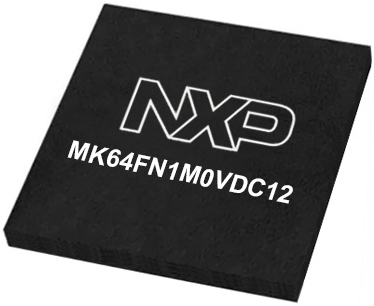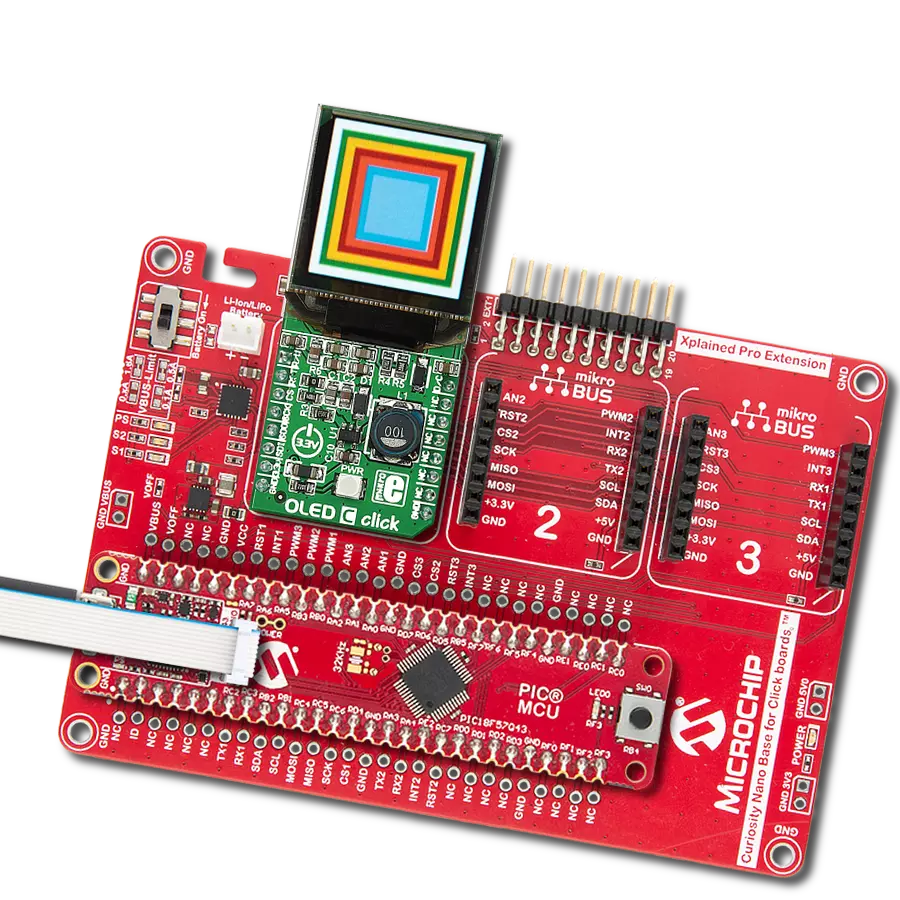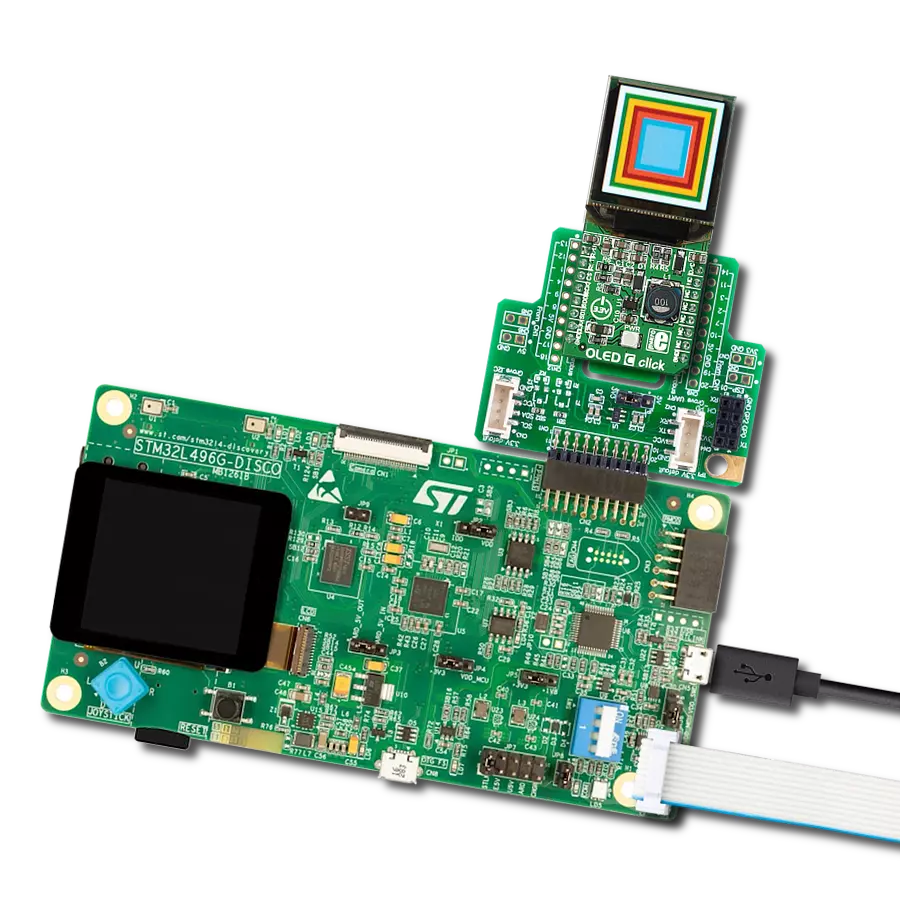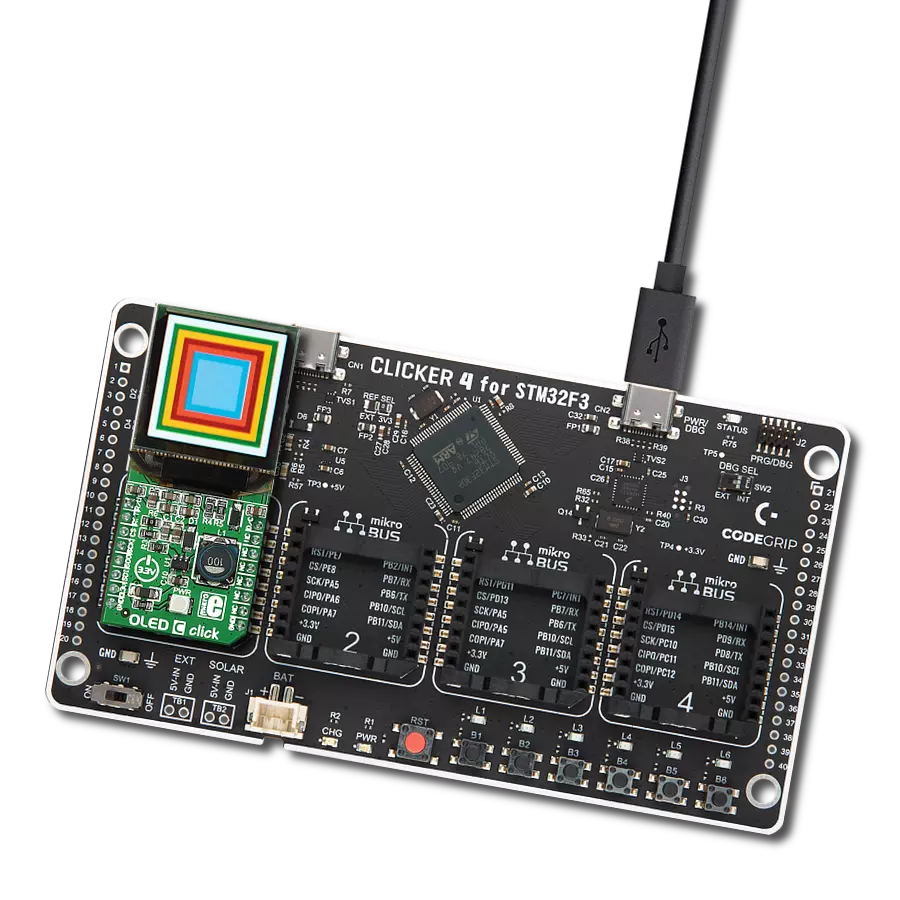Witness how this smart display reimagines the way we interact with our devices, offering a beautiful and intuitive solution that simplifies everyday tasks and elevates your space.
A
A
Hardware Overview
How does it work?
OLED Switch Click is based on the ISC15ANP4, a programmable smart display from NKK Switches. The OLED display has a 64x48 pixels resolution with up to 65K colors (16-bit depth), or 256 colors in 8-bit mode, and a 180° viewing angle. The life expectancy is up to 60000 hours depending on the luminance of the display and the percentage of the pixels set to on. The display is perfect for displaying simple information, whether as icons or words. The most interesting feature is that the display can be programmed to change the picture when needed. For example, you can design a reprogrammable keypad that switches from Latin to Cyrillic script or Chinese characters. The internal frame buffer on the OLED display holds 96x64 pixels with 2 bytes of 565 formatted color information for each. When displaying an image that is the size of the display (64x48), the image
will be displayed well unless scrolled. To scroll an image without having random pixels from unused space in the internal frame buffer, load a 96x64 image onto the OLED Switch Click with your desired image centered like the blue-colored area or similar. VisualTFT can be used to prepare the BMP images. There is a learn.microe.com article that explains how to take 16 or 24-bit BMP pictures and create C arrays. The article is about RGB matrices, but the same principle applies. The mechanical button itself is nicely built, with translucent black housing. When pressed, it gives satisfying tactile feedback and has a distinct, long travel of 4.5mm. Its contacts have a 0.1A@12VDC rating to switch an external circuit over screw terminals. The internal button circuit is an SPST and is normally open. The pressure on the button itself above 100N can damage the OLED. In
addition, this Click board™ features the MAX8574, a high-efficiency LCD boost with true shutdown from Analog Devices, that serves as a main OLED drive circuit power supply obtained from the mikroBUS™ 3.3V power rail. The OLED Switch Click uses an SPI serial interface to communicate with the host MCU. In addition, the OLED can be reset over the RST pin, and a CD pin can set data to be interpreted as a Command or as Data depending on the logic state. The host MCU cannot know the push button’s state over the mikroBUS™ socket. This Click board™ can be operated only with a 3.3V logic voltage level. The board must perform appropriate logic voltage level conversion before using MCUs with different logic levels. Also, it comes equipped with a library containing functions and an example code that can be used as a reference for further development.
Features overview
Development board
Clicker 2 for Kinetis is a compact starter development board that brings the flexibility of add-on Click boards™ to your favorite microcontroller, making it a perfect starter kit for implementing your ideas. It comes with an onboard 32-bit ARM Cortex-M4F microcontroller, the MK64FN1M0VDC12 from NXP Semiconductors, two mikroBUS™ sockets for Click board™ connectivity, a USB connector, LED indicators, buttons, a JTAG programmer connector, and two 26-pin headers for interfacing with external electronics. Its compact design with clear and easily recognizable silkscreen markings allows you to build gadgets with unique functionalities and
features quickly. Each part of the Clicker 2 for Kinetis development kit contains the components necessary for the most efficient operation of the same board. In addition to the possibility of choosing the Clicker 2 for Kinetis programming method, using a USB HID mikroBootloader or an external mikroProg connector for Kinetis programmer, the Clicker 2 board also includes a clean and regulated power supply module for the development kit. It provides two ways of board-powering; through the USB Micro-B cable, where onboard voltage regulators provide the appropriate voltage levels to each component on the board, or
using a Li-Polymer battery via an onboard battery connector. All communication methods that mikroBUS™ itself supports are on this board, including the well-established mikroBUS™ socket, reset button, and several user-configurable buttons and LED indicators. Clicker 2 for Kinetis is an integral part of the Mikroe ecosystem, allowing you to create a new application in minutes. Natively supported by Mikroe software tools, it covers many aspects of prototyping thanks to a considerable number of different Click boards™ (over a thousand boards), the number of which is growing every day.
Microcontroller Overview
MCU Card / MCU

Architecture
ARM Cortex-M4
MCU Memory (KB)
1024
Silicon Vendor
NXP
Pin count
121
RAM (Bytes)
262144
Used MCU Pins
mikroBUS™ mapper
Take a closer look
Click board™ Schematic

Step by step
Project assembly
Track your results in real time
Application Output
1. Application Output - In Debug mode, the 'Application Output' window enables real-time data monitoring, offering direct insight into execution results. Ensure proper data display by configuring the environment correctly using the provided tutorial.

2. UART Terminal - Use the UART Terminal to monitor data transmission via a USB to UART converter, allowing direct communication between the Click board™ and your development system. Configure the baud rate and other serial settings according to your project's requirements to ensure proper functionality. For step-by-step setup instructions, refer to the provided tutorial.

3. Plot Output - The Plot feature offers a powerful way to visualize real-time sensor data, enabling trend analysis, debugging, and comparison of multiple data points. To set it up correctly, follow the provided tutorial, which includes a step-by-step example of using the Plot feature to display Click board™ readings. To use the Plot feature in your code, use the function: plot(*insert_graph_name*, variable_name);. This is a general format, and it is up to the user to replace 'insert_graph_name' with the actual graph name and 'variable_name' with the parameter to be displayed.

Software Support
Library Description
This library contains API for Oled Switch Click driver.
Key functions:
oledswitch_reg_write- This function writes to control and configuration registers on the chipoledswitch_digital_write_pwm- This function sets the digital output signal for the PWM pinoledswitch_digital_write_rst- This function sets the digital output signal for the RST pin
Open Source
Code example
The complete application code and a ready-to-use project are available through the NECTO Studio Package Manager for direct installation in the NECTO Studio. The application code can also be found on the MIKROE GitHub account.
/*!
* \file
* \brief OledSwitch Click example
*
* # Description
* This example showcases how to configure and use the OLED Switch Click. This Click is a
* combination of a button and a full color organic LED display. Displays settings are first
* loaded onto the chip and after that you can show any 64x48 pixel image on the display.
*
* The demo application is composed of two sections :
*
* ## Application Init
* This function initializes and configures the Click modules. In order for the
* Click to work properly, you need to configure display and power settings.
* The full initialization of the chip is done in the default_cfg(...) function.
*
* ## Application Task
* This function shows the user how to display images on the OLED screen. Every image you'd
* like to display needs to have a resolution of 64x48 and be stored in a 6144 cell array.
*
* @note
* Every pixel on the OLED screen is displayed at the time of writing to the chip (PWM 1).
* Displaying speed can be directly controled by adding delays in the for loop section of
* the draw_image(...) function.
*
* \author MikroE Team
*
*/
// ------------------------------------------------------------------- INCLUDES
#include "board.h"
#include "log.h"
#include "oledswitch.h"
#include "oledswitch_image.h"
// ------------------------------------------------------------------ VARIABLES
static oledswitch_t oledswitch;
// ------------------------------------------------------ APPLICATION FUNCTIONS
void application_init ( )
{
oledswitch_cfg_t cfg;
// Click initialization.
oledswitch_cfg_setup( &cfg );
OLEDSWITCH_MAP_MIKROBUS( cfg, MIKROBUS_1 );
oledswitch_init( &oledswitch, &cfg );
oledswitch_default_cfg( &oledswitch, OLEDSWITCH_BUFFER_SIZE_SMALL );
}
void application_task ( )
{
oledswitch_draw_image( &oledswitch, array_red, OLEDSWITCH_IMG_SIZE_NORMAL );
Delay_1sec( );
oledswitch_draw_image( &oledswitch, array_green, OLEDSWITCH_IMG_SIZE_NORMAL );
Delay_1sec( );
oledswitch_draw_image( &oledswitch, array_blue, OLEDSWITCH_IMG_SIZE_NORMAL );
Delay_1sec( );
}
int main ( void )
{
/* Do not remove this line or clock might not be set correctly. */
#ifdef PREINIT_SUPPORTED
preinit();
#endif
application_init( );
for ( ; ; )
{
application_task( );
}
return 0;
}
// ------------------------------------------------------------------------ END


































